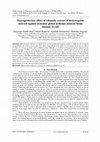Papers by santhosha dasarapu

Background The human gut microbiota (GM) is a diverse ecosystem crucial for health, impacting phy... more Background The human gut microbiota (GM) is a diverse ecosystem crucial for health, impacting physiological processes across the host's body. This review highlights the GM's involvement in Non-Alcoholic Fatty Liver Disease (NAFLD) and explores its diagnosis, treatment, and management. Main Text The GM influences gut functionality, digestion, immunity, and more. Short-chain fatty acids (SCFAs), produced by microbial fermentation, regulate metabolism, inflammation, and immune responses. Bile acids (BAs) modulate the microbiome and liver functions, affecting NAFLD progression. Dysbiosis and increased gut permeability contribute to NAFLD through bacterial components and metabolites reaching the liver, causing inflammation and oxidative stress. The microbiome's impact on immune cells further exacerbates liver damage. Symptoms of NAFLD can be subtle or absent, making diagnosis challenging. Imaging techniques assist in diagnosing and staging NAFLD, but liver biopsy remains vital for accurate assessment. Promising treatments include FXR agonists, GLP-1 agonists, and FGF19 and FGF21 mimetics, targeting various pathways associated with NAFLD pathogenesis. Fecal Microbiota Transplantation (FMT) emerges as a potential therapeutic avenue to restore gut microbiota diversity and alleviate NAFLD. Lifestyle interventions, such as dietary modifications, exercise, and probiotics, also play a pivotal role in managing NAFLD and restoring gut health. Conclusion Despite significant progress, the complex interplay between the gut microbiome, NAFLD, and potential treatments necessitates further research to unravel underlying mechanisms and develop effective therapeutic strategies.
Annals of phytomedicine, Nov 30, 2023
Egyptian Liver Journal/Egyptian Liver Journal, Apr 25, 2024
International research journal of pharmacy, Aug 16, 2015
The aim of the present study was to investigate phyto chemical screening and anti-oxidant activit... more The aim of the present study was to investigate phyto chemical screening and anti-oxidant activity of the ethanol extract of the whole plant of Heliotropium indicum. The ethanolic extract of the whole plant of Heliotropium indicum was studied for its anti-oxidant effect. During phytochemical screening flavonoids and phenols were found abundantly. Ethanolic extract of Heliotropium indicum was screened to evaluate free radical scavenging effect. The extract exhibited significant reducing power and free radical scavenging effect. This antioxidant activity was concentration dependant which was compared with standard antioxidant such as Ascorbic acid.

IOSR Journal of Pharmacy and Biological Sciences, May 1, 2016
Heliotropium indicum is a whole herb used as traditional medicine mainly in India for the treatme... more Heliotropium indicum is a whole herb used as traditional medicine mainly in India for the treatment of mental disorders and as brain tonic since many years. The present study is to investigate the protective effects of ethanolic extract of whole herb of Heliotropium indicum on cerebral ischemia/reperfusion induced brain damage in rats. Cerebral ischemia was induced by occluding bilateral common carotid arteries for 60 min followed by 3h of reperfusion. Ischemia/reperfusion-induced neuronal injury was assessed by measurement of brain infarct area, biochemical estimations and histopathological studies. Pretreatment of Heliotropium indicum extract (200, 280 and 400 mg/kg, p.o.) significantly reduced the lipid peroxidation, increased the total thiol content, Catalase and glutathione-S-transferase activity in brain homogenates. The decreased cerebral infarction area in Extract-treated groups and histopathological sections confirmed the above findings. These observations reveal that Heliotropium indicum is a neuroprotective agent and may prove to be useful adjunct in the treatment of stroke and neurological disorders.

Stroke, 2022
Background: In 2020, a large integrated healthcare system consisting of 21 stroke centers impleme... more Background: In 2020, a large integrated healthcare system consisting of 21 stroke centers implemented IV tenecteplase as the first line pharmaceutical treatment for acute ischemic stroke (AIS) prior to universal adoption in national clinical practice guidelines and FDA approval for stroke. Purpose: To describe the steps taken for successful implementation of IV tenecteplase as a first therapy for AIS in 21 stroke centers, part of an integrated system. Methods: Pre-implementation steps included gaining systemwide acceptance, especially from key stakeholders such as emergency department staff, patient care services, tele-stroke and neurology physicians, as well as risk management. We addressed potential impacts to related to reimbursement, stroke certification, and national award status. Inclusive changes were made to related policy and procedures, order sets, and other documentation. Standardized training and beta-testing were conducted and a sequential roll-out implemented along the...
New and Future Developments in Microbial Biotechnology and Bioengineering, 2022
Uploads
Papers by santhosha dasarapu